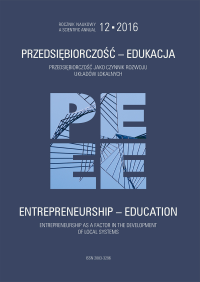Conditions for Development of Human Capital in Rural Areas of the Podlaskie Voivodeship
DOI:
https://doi.org/10.24917/20833296.12.4Keywords:
conditions for development, human capital, rural areasAbstract
Socio-economic development results in constant changes in the structure and in the hierarchy of factors determining the evolution of economies. This also applies to rural areas. In every region of the country there may be differences in the level of economic development and quality of life of its inhabitants. This is due to, among other things, their human resources and their quality and their function in society. One of the most important factors of socio-economic development of the region is human capital. Its role and resources are conditioned not only by the size of the population, but mainly knowledge, entrepreneurship, creativity, ability, health, and other similar features in the region. The development of the human factor is an important course of action in solving socio-economic problems in rural areas Podlaskie. In the age of the developed computerization, the technology and the innovation in order to meet challenges of the future, it is becoming necessary to use the knowledge, qualifications and the abilities of human resources as most valuable capital of every enterprise of the 20th century. The aim of this study is to present the key determinants of human capital development in rural areas of Podlaskie.References
Bank Danych Lokalnych GUS (2015, 27 sierpnia). Pozyskano z: www.stat.gov.pl Bański, J. (2008). Wiejskie obszary sukcesu gospodarczego. Studia Obszarów Wiejskich, 14, 31–39.
Barro, R.J., Sala-i-Martin, X. (2004). Economic growth. Cambridge, Massachusetts: MIT Press.
Barro, R.J., Lee, J.W. (2011; 2015, 10 czerwca). A New Data Set of Educational Attainment in the World. Pozyskano z: http://www.barrolee.com/papers/Barro_Lee_Human_Capital_Update_2011Nov.pdf
Becker, G.S. (1960). An Economic Analysis of Fertility. W: G.B. Roberts (red.), Demographic and Economic Change in Developed Countries. Universities-National Bureau, 209–240.
Becker, G.S. (1993). Human capital, A theoretical and empirical analysis, with special reference to education, Third edition, Chicago – London: Chicago University Press.
Blang, M. (1976). The empirical status of human capital theory: a slightly jaundiced survey. American Economic Association. Journal of Economic Literature, 14(3), 829–830.
Cichy, K. (2005). Kapitał ludzki w modelach i teoriach wzrostu gospodarczego. Zeszyty Studiów Doktoranckich, 23, 37–41.
Czaja, Z. (2011). Problemy zarządzania zasobami ludzkimi w administracji samorządowej. „Optimum”. Studia Ekonomiczne, 1, 128–136.
Denison, E.F. (1962). The Sources of Growth in the US. New York: Committee for Economic Development.
Domański, S.R. (1993). Kapitał ludzki i wzrost gospodarczy, Warszawa: PWN.
Fitz-Enz, J. (2001). Rentowność inwestycji w kapitał ludzki. Krakow: Oficyna Ekonomiczna.
Freinkel, J. (2012; 2015, 10 czerwca). The role of hyaluronan in wound healing. Pozyskano z: http://www. ncbi.nlm.nih.gov/pubmed/22891615
Heffner, K., Rosner A. (2005). Czynniki rozwoju obszarów wiejskich – rola małych miast. W: A. Rosner (red.), Uwarunkowania i kierunki przemian społeczno-gospodarczych na obszarach wiejskich, Warszawa: Wyd. IRWiR PAN, 229–330.
http://www.pops.up.podlasie.pl/index.php/strony/9844.html Janc, K. (2003). Rola nauki i techniki we wspołczesnym świecie. W: H. Śmigielska, J. Słodczyk (red.), Geograficzne aspekty globalizacji i integracji europejskiej, Opole: PTG UO, 311–317.
Janc, K., Czapiewski, K.Ł. (2014). Polaryzacja zagadnień edukacyjnych na Mazowszu wyzwaniem rozwoju obszarów wiejskich. Studia Komitetu Przestrzennego Zagospodarowania Kraju PAN, 156, 335- 357.
Kaleta, A. (2009). Obszar wiejski i koncepcje jego rozwoju. Warszawa: Wyd. FAPA.
Kaplan, R.S., Norton, D.P. (2001). Strategiczna karta wyników. Jak przedłożyć strategię na działanie. Warszawa: PWN.
Krol, H., M., Ludwiczyński, A. (red.) (2006). Kapitał ludzki organizacji. W: H. Krol, M. Ludwiczyński, Zarządzanie zasobami ludzkimi. Tworzenie kapitału ludzkiego organizacji, Warszawa: PWN, 111– 119.
Lukas, R. (1988; 2015, 10 czerwca). Interannual fluctuations of the Mindanao Current in feed from sea level. Pozyskano z: http://onlinelibrary.wiley.com/doi/10.1029/JC093iC06p06744/full
Łukasiewicz, G. (2009). Kapitał ludzki w organizacji pomiar i sprawozdawczość. Warszawa: PWN.
Mankiw, N.G., Romero, D. (1992). A Contribution to the Empirics of Economic Growth. Quarterly Journal of Economics, 107, 407–438.
Mincer, J. (1958). Investment in human capital and personal income distribution. Journal of Political Economy, 66(4), 30–36.
Przyszczypkowski, K. (2002). Partnerstwo edukacyjne jako forma kapitału społecznego w gospodarce opartej na wiedzy, Warszawa: PWN.
Roczniki Statystyczne GUS z lat 2003–2014. GUS (2015, 10 czerwca). Pozyskano z: www.stat.gov.pl
Roczniki Demograficzne GUS z lat 2003–2014. GUS (2015, 10 czerwca). Pozyskano z: www.stat.gov.pl
Romer, P. (1990). Endogenous Technological Change. Journal of Political Economy, 96, 71–102.
Schultz, T.W. (1962). Reflections on investment in man. Journal of Political Economy, 70, 1–8.
Smith, A. (1954). Badania nad naturą i przyczynami bogactwa narodow, Warszawa: PWN Strategia rozwoju województwa podlaskiego do roku 2020 (2015, 27 sierpnia). Pozyskano z: http://www.strategia.wrotapodlasia.pl/pl/ps2/var/resources/154/248/4/srwp_2020_1.pdf
Szanse i zagrożenia oraz potencjalne kierunki rozwoju obszarów wiejskich w Polsce w ujęciu regionalnym.
Raport podsumowujący. (2012). Agrotec Polska Sp. z o.o. & Instytut Geografii i Przestrzennego Zagospodarowania PAN, Warszawa.
Zioło, Z. (2010). Rola zasobów intelektualnych, kapitału ludzkiego i społecznego w procesach rozwoju obszarów wiejskich. W: W. Kamińska, K. Heffner (red.), Kapitał ludzki i społeczny w procesie rozwoju obszarów wiejskich, Studia KPZK PAN T. CXXVI, Warszawa.
Downloads
Published
How to Cite
Issue
Section
License
Articles are published under the terms of the Creative Commons License (CC BY-ND 4.0; Attribution– NoDerivs).

